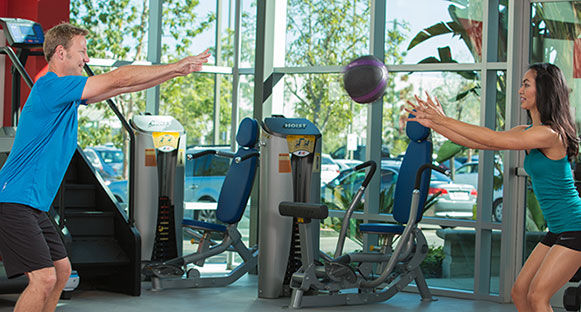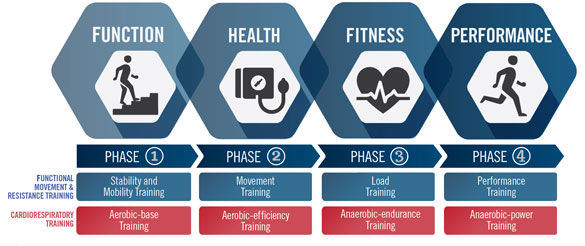
Power or explosive exercises are most often used to enhance athletic performance, but they also can provide many useful benefits for clients of all fitness levels. Whether your clients are competing at an elite level or just want to remain injury-free for their favorite leisure-time activities, learn why power exercises can deliver big results in less time.
Think of a favorite movie. You can watch it over and over, but once you’ve memorized all the lines, it starts to lose some of its entertainment value. How the brain learns lines to a movie is similar to how the human body adapts to exercise. The more often a particular exercise is performed, the more efficient the body becomes at executing the movement. If the same exercises are performed with the same intensity for the same number of repetitions over a period of time, the body will burn fewer calories to perform the work. And, because physiological changes are no longer occurring, a plateau is reached.
Physiological adaptations to exercise occur when the intensity of exercise is greater than the existing work capacity of involved muscles. For personal trainers and group fitness instructors developing exercise programs for clients and classes, it is necessary to change workout programs on a regular basis to ensure they have the desired affect. When designing exercise programs, one of the most important things to remember is that a physical overload must be applied to the working muscles.
There are two methods of changing an exercise stimulus, both of which can be used to help clients reach their goals (Zatsiorsky and Kraemer, 2006):
- Quantitatively — changing the actual intensity or amount of resistance used
- Qualitatively — changing the exercises to challenge the neural and structural components of a muscle to adapt to a new movement pattern or motor skill
The Overload Principle
The overload principle of exercise program design dictates that achieving results from exercise requires challenging a physiological system to perform a greater amount of work than it is currently able to perform (Baechle and Earle, 2008). An effective method for improving muscle force output is to apply a physical stimulus to the neuromuscular system at intensities greater than it is accustomed to receiving. The physiological response of the involved muscles to an applied stress is to be able to perform more work.
Strength training stimulates specific neural and structural adaptations that can improve the size and force-production capacity of skeletal muscle. One effect of a progressively challenging overload is the activation of greater numbers of muscle motor units and the fibers to which they attach. An appropriately applied overload can improve the neural efficiency at which the muscle communicates with the central nervous system (CNS), while also increasing the size or structure of a muscle.
The ACE Integrated Fitness Training Model

The ACE Integrated Fitness Training® (ACE IFT®) Model offers fitness professionals a comprehensive system for designing exercise programs that apply effective overloads. The ACE IFT Model provides strategies for enhancing movement skill while simultaneously improving flexibility, balance, cardiorespiratory fitness and specific types of strength. Regardless of what an individual’s specific fitness goals might be, the ACE IFT Model provides a systematic format for reaching those objectives.
The purpose of phases 1 and 2 of the ACE IFT Model is to establish a foundation of movement efficiency by improving joint range of motion, core stability, coordination and muscular endurance, all of which serve as a necessary foundation for more challenging exercise programs. Exercises in phase 1 of the functional movement and resistance training component of the ACE IFT Model—stability and mobility training—improve joint stability and mobility while enhancing the strength and endurance of the muscles responsible for core stability and good posture. If a client is new to exercise or has been sedentary for an extended period of time, starting in phase 1 helps ensure success in the other phases of training. Phase 2 focuses on movement training, and the exercises are designed to teach a client how to move efficiently and effectively through the foundational patterns of exercise: squatting, lunging, pushing, pulling and rotating. For more experienced clients with existing levels of strength and movement efficiency, the exercises from phases 1 and 2 can be used for an effective dynamic warm-up.
Programming for phase 3—load training—focuses on recruiting the type II muscle fibers responsible for increases in muscle size and strength by using greater resistance. The ACE IFT Model can be used to design programs that cycle between the different goals of strength training—endurance, hypertrophy and strength—to help clients avoid plateaus and efficiently achieve results. Programming for phase 4—performance—adds a velocity component by training to sustain muscle force for an extended period of time, which is known as endurance, or using exercises to increase the ability to generate explosive muscle force, known as power. Strength training in the load phase addresses the production of muscular force, while power training in the performance phase conditions an individual to generate a high magnitude of force in a short period of time.
A power-training program requires muscle tissue to make both neural adaptations, which change the speed in which contractions occur, and structural adaptations, which promote changes in muscle strength and size. Muscle strength and power are separate skills that should be trained with specific programs. Power-training exercises can help clients achieve a wide range of fitness goals, as long as there are no existing injuries or muscle imbalances that inhibit skilled movement or limit joint range of motion. For older adults, the safe application of power-training exercises can be important for maintaining functional independence during the aging process.
Incorporating power training into group fitness programs is also important. “Power exercises help increase the efficiency of how muscles work,” explains Kimmel Yeager, group fitness manager for Equinox in Irvine, Calif., “which is an important component of good health.”
But what about the risk of injury with power training? “There is no ‘one-size-fits-all’ when it comes to group fitness,” says Yeager. “I cue my classes to work to their individual ability levels. Participants usually run the gamut from young athletes to ‘more seasoned’ adults. To minimize the risk of injury, I tend to use power and plyometrics exercises earlier in the class after movement prep and warm-ups. Doing power exercises at the end of class when participants are fatigued could increase the risk of injury, which we want to avoid at all costs.”

Structural Adaptations
Improvements in muscle size and strength occur as the result of structural adaptations to an imposed training stimulus. Strength training during the load phase increases the force generated when the contractile element of the actin and myosin protein filaments slide across one another. When a muscle experiences a shortening action, it places a significant tension on the fascia and connective tissue of the elastic component, which can enhance muscle power by reducing the time of the stretch-shorten cycle (SSC) (Verkoshansky and Siff, 2009).
The SSC describes how muscles produce mechanical energy. The eccentric phase of the SSC stores potential energy as a muscle lengthens, while the concentric shortening phase releases the energy as a muscle returns to resting length. A traditional tempo of exercise is usually 1 to 3 seconds in each of the eccentric and concentric phases of action. Power exercises improve the velocity of muscle-force production by enhancing the coordination between the contractile and elastic components of muscle, which reduces the time of the SSC. Minimizing the transition time between the lengthening and shortening phases of action increases a muscle’s rate of force production and power output. It is helpful to think of the SSC as a rubber band. If a rubber band is stretched and held in a lengthened position before being released, it won’t produce the same amount of explosive force as when the band is rapidly pulled and immediately released. Rapid stretch-shortening muscle actions are an integral component of training for athletic performance and for enhancing the rate of force development specific to many activities of daily living (ADL).
Additional structural adaptations include the quality and quantity of muscle protein and anaerobic enzymes, both of which affect the structure of a muscle. Specific structural changes include:
- Increasing the quantity of enzymes necessary for anaerobic metabolism
- Elevating the amounts of energy substrates (e.g., phosphagen and glycogen) stored in muscle
- Increasing the contractile proteins of myosin and actin
Additionally, as the myosin-heavy chains become thicker, muscle contractions occur with more velocity and greater amounts of force. Power training not only affects the muscular system, it also improves the strength and density of connective tissue, such as tendons and ligaments, as well as the osseous structures of bone (Baechle and Earle, 2008).
Neural
The CNS is a critical component in the process of enhancing muscular power. Power training can condition the contractile components of the muscular system to improve timing and coordination, which increases the magnitude and velocity of force production. Muscle spindles are sensory receptors that identify changes in muscle length and then communicate those changes to the CNS to determine and produce the appropriate motor response. Muscle spindles lie parallel to individual muscle fibers and sense changes in both muscle length and the velocity of the length change. When a muscle is lengthened, it creates a stretch on the muscle spindles, which respond by initiating a discharge of the alpha motor neurons. This, in turn, causes a reflexive contraction of the involved muscle (Verkoshansky and Siff, 2009).
A muscle motor unit is the basic CNS component responsible for stimulating individual muscle fibers to shorten. An individual motor unit is comprised of a motor neuron, which receives the commands for action from the CNS, and its attached muscle fibers. Motor units can be classified as fast-twitch or slow-twitch. Slow-twitch motor units have a low threshold for activation, low conduction velocities and are best suited for long-duration activity requiring minimal force output because they attach to slow-twitch, type I, muscle fibers. Fast-twitch motor units, on the other hand, have a higher activation threshold, are capable of conducting signals at higher velocities, and are better suited to anaerobic strength and power-based activities because they attach to type II muscle fibers, which have the ability to produce a high amount of force in a short period of time. Motor units are activated according to the all-or-none theory, which postulates that when a motor unit is activated it shortens all of its attached muscle fibers (Zatsiorsky and Kraemer, 2006).
Muscle force output is based not only on the size of the muscle or individual muscle fibers, but also on intramuscular coordination, the efficiency with which the CNS activates individual fibers within a particular muscle. This is based on three separate components:
- Muscle fiber recruitment: rapid lengthening during the eccentric phase of the SSC will stimulate muscle spindles to activate higher numbers of muscle motor units within a specific muscle
- Synchronization: the activation of a number of greater numbers of motor units simultaneously to increase the force output
- Rate coding: the speed at which the CNS activates motor units. In general, faster firing rates of muscle motor units lead to an increase in muscle power.
Intermuscular coordination is the ability to activate many muscles at the same time to achieve maximal force output for a specific movement. CNS adaptations are primarily responsible for increasing both intra- and intermuscular coordination, which ultimately enhances the rate of force production and total power output for a particular movement. Co-contraction is the simultaneous activation of muscles on both sides of a joint, traditionally referred to as the agonist and antagonist for a particular movement. Increasing the neural efficiency of muscles can allow an antagonist to relax at a faster rate during an agonist muscle action, leading to an increased rate of force production and a faster movement velocity (Verkoshansky and Verkoshansky, 2013).
Methods of Power Training
When introducing power-training exercises, it is important to start with low-intensity exercises for a limited volume to allow the musculoskeletal system to adapt to the faster SSC velocities. Progressing to higher-intensity exercises can yield greater results, but this requires longer rest periods between sets to allow the structural and neural properties of muscle to experience an appropriate recovery.
Shana Verstegen, an ACE Certified Personal Trainer and professional lumberjack athlete in Madison, Wisc., feels comfortable using a variety of power-training exercises with her clients. “All of my clients receive some form of power training during their workouts, but the type of training varies drastically depending on their skill level and goals," explains Verstegen. “Everybody should have some form of dynamic movement in their workouts, because in life we are often faced with the need to move and change direction quickly. We do not live in a 2 counts up, 1 count hold and 2 counts down world.”
Depending on a client's specific sport, movement mechanics and ability to handle an eccentric load, Verstegen will use plyometric exercises to varying degrees. “Before we add things like bounding, box jumps and plyo push-ups to their programming, it is essential they have built up a solid strength base," says Verstegen. "For my non-athletes, power-training exercises could be anything from adding some speed to body-weight exercises to adding faster movements when using lighter loads like resistance bands.”
Teaching power exercises requires the ability to watch participants closely. Learning the technical skills required to perform explosive movements can be a lengthy process requiring a lot of feedback to help refine the skill. Efficient, skilled movement improves technique, which can lead to the ability to achieve greater results by training with heavier loads. Power-training exercises include plyometric jumps to develop lower-body power, medicine-ball throws to improve upper-body power, and weightlifting exercises like the snatch or clean-and-jerk to enhance total-body power output.

For healthy clients with good movement efficiency and no muscle imbalances, power exercises make it possible to increase the challenge of their program, making it possible to do more work in less time, which can make workouts more effective. Monica Ammann, an ACE Certified Group Fitness Instructor in San Diego, uses short bursts of plyometric exercises in her interval-conditioning classes. Power-training exercises, she says, “increase the level of difficulty, while adding variety, both of which are important for engaging participants to keep them coming back for more.”
When you design exercise programs, your objective is to help your clients achieve their personal fitness goals in the most efficient manner possible. Most training sessions and group fitness classes are 60 minutes or less and power training can be an effective technique for stimulating physiological changes in a short period of time. Whether they are competing at an elite level or just want to remain injury-free for their favorite leisure-time activities, power exercises can deliver results.
References
Baechle, T.R. and Earle, R.W. (2008). Essentials of Strength and Conditioning (3rd ed.). Champaign, Ill.: Human Kinetics.
Verkoshansky, Y. and Siff, M. (2009). Supertraining (6th ed.). Rome, Italy: Verkoshansky. Institute.
Verkoshansky, Y. and Verkoshansky, N. (2013) Special Strength Training Manual for Coaches. Rome, Italy: Verkoshansky Institute.
Zatsiorsky, V. and Kraemer, W. (2006). Science and Practice of Strength Training (2nd ed.). Champaign, Ill.: Human Kinetics.





 by
by 





